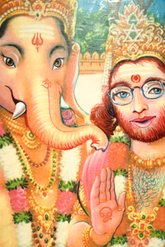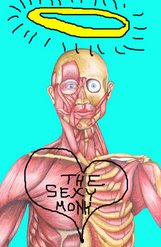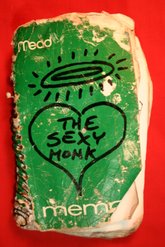
Scattered along the bottom of this picture are sketches of several small items drawn in black and white- a couple of dominoes, a few seashells, chicken bones, and some other random stuff. It looks like a collection from the bottom of a particularly poorly tended kitchen junk drawer. But, in reality, this is a full set of ditaula (bones.) Each item in a set of bones represents either one of the members of an extended African family or an abstract quality(love, hate, fear, etc.) Bones are to a sangoma (traditional healer/shaman) what a deck of Tarot cards or a crystal ball is to a Gypsy fortune teller. During a reading of the bones, the entire set is dropped on to a mat. Supposedly, the relative position of one piece to another and whether a piece was showing "heads" or "tails," tells the entire history of a person's past and future. From my scientific viewpoint, a successful reading of a set of bones has a lot more to do with the observational powers and physiological sophistication of the reader than anything else. However, I saw many people comforted by a good reading. So, who am I to judge? Not all sangomas use bones as part of their work. My teacher and guide to African spirituality, Mma Seitsang (see the essay entitled "About the South Africa Series" found at the bottom of the site) did not use them, although she was looking to acquire the skill when I left Africa in December of 2005. This particular set belongs to my friend Mmagogo ("Granny" in Zulu.) Mmagogo is from Swaziland (the little landlocked mountain kingdom surrounded by South Africa) and works in the traditional medicine shop in the town Vryburg. She is the quintessential sangoma- as round, quiet, and laughing as a Japanese Buddha, but with a spine of spiritual steel. I first met Mmagogo in 2003 when I was exploring Vryburg's small shops and back alleys. Vryburg is the town nearest to both Mma Seitsang's home in Kudunkwane and village of Tlakgameng where I did my Peace Corps Service. I went there every three weeks or so to visit the library, buy food that I couldn't get at village shops, and eat a big greasy cheeseburger. I recognize how lucky I was to have these conveniences as a Peace Corps Volunteer. Most PCV's may only find grocery stores, burger joints, and other goodies in the diplomatic area of their host country, if at all. The first time I stepped in to her shop, Mmagogo was immediately welcoming, even though, as a snooping white foreigner, I was the opposite of her regular clientele. As an artist, she always treated me with the same respect that she accorded to her fellow sangomas and, in three years, never tried to sell me anything, "read my palm," or diagnose any mysterious ailment. Most of our conversations centered around our dreams and visions. This is a topic that makes most people's eyes glaze over, but dreams are both the artist's and the sangoma's bread and butter. In a very short time my visits to the muti (traditional medicine) shop became as essential a stop at the grocery store when I was in town. I was always amazed by Mmagogo's lack of fear while revealing amazing details about her inner life. I tried to follow her example when I was creating the drawings for this series- bringing unedited thoughts out into the open. In the back of the muti shop was a small room where Mmagogo conducted patient consultations and read bones. I knew her for quite a while, before I asked to take a peek in the back room, and for more than two years before I asked to draw her bones. Bones are private items. Asking to draw her bones was akin to me asking to draw her underwear. Mmagogo was gracious enough to allow me to lie on the floor of her consultation room and do the detailed renderings seen here, though I was interrupted many times by patients needing a reading. In the center of this picture is a brick by brick drawing of one of the buildings that comprised the family compound of my Peace Corps host family: the amazing Khorae's (much more about them another day.) On the left hand side of the picture are sketches of dancers that did at a sangoma celebration that took place outside of the city of Bloemfontein(ditto-more later.)



No comments:
Post a Comment